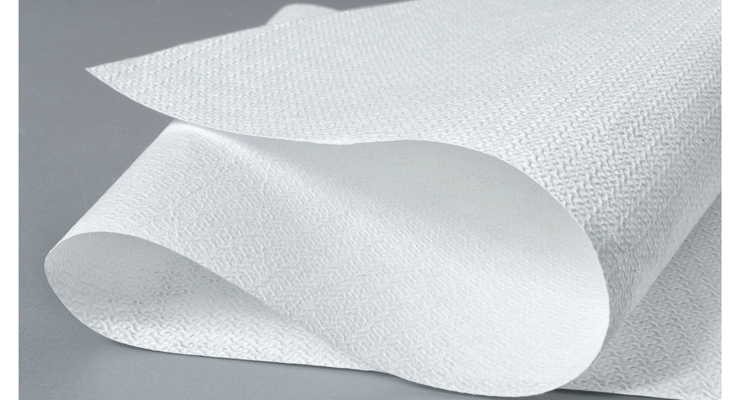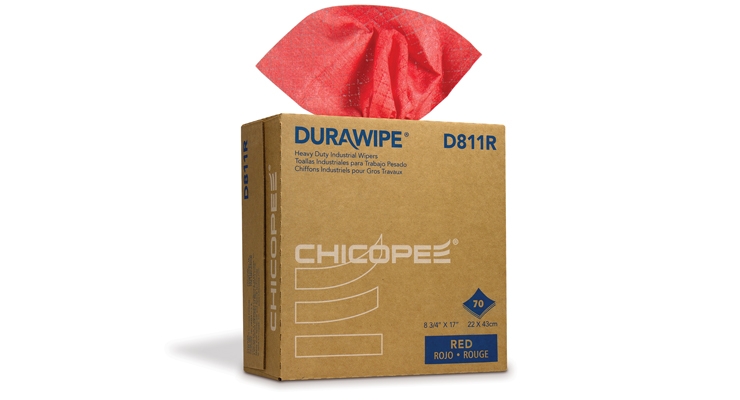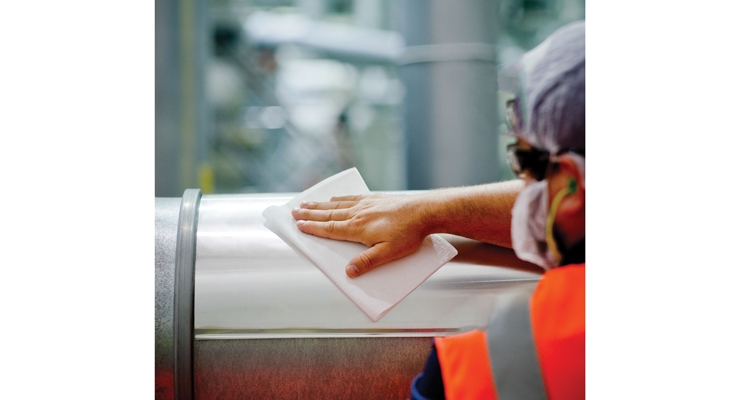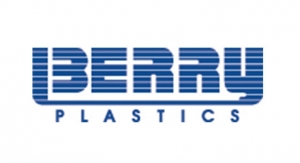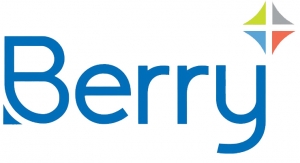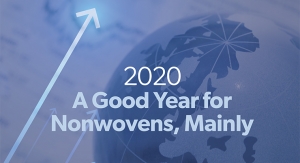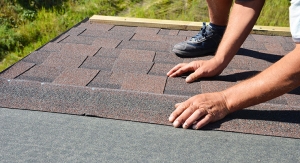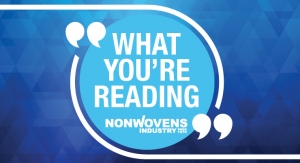Tara Olivo, Associate Editor10.11.19
Nonwovens manufacturers are optimistic about growth for industrial wipes substrates. Nonwoven-based wipers continue to displace reusable and launderable rags in a range of industries including industrial facilities and manufacturing plants, as well as food service facilities, healthcare facilities and lodging establishments.
The increasing adoption of nonwoven wipers can be credited for several reasons. Because they can be engineered to incorporate specific features, nonwovens can outperform textile wipers and rags. For instance, some can absorb more liquid, more quickly than rags, while also leaving less lint behind. Nonwovens can also provide consistency in both size and performance, while shop rags can vary in size and can contain contaminants such as heavy metal residue from other workplaces, even after being laundered.
For industrial applications, Berry Global is seeing a shift from rags or towels to a nonwoven wiper. “By using a nonwoven wipe, the user is guaranteed a fresh and clean towel every time, eliminating the need to dig through a pile of rags to find one rag suitable for the task at hand,” says Julianne Hawk, product line management, Packaged Goods, HH&S Division of Berry Global. “Because of a nonwoven’s durability and increased towel longevity, less waste ends up in landfills.”
Wipes made from nonwovens can be disposed of either right away after single use to help minimize or even eliminate risk for cross-contaminates—to clean properly—or they can be used more than a few times in a more robust environment such as in automotives, says Johanna Sirén, category manager, Professional at nonwovens producer Suominen. “With nonwovens you will also have every time a brand new clean wipe with the same properties as the ‘last time,’ as the repeated washing will not destroy the structure of the wipe by having holes or losing fibers to create the difficult lint,” she explains.
By The Numbers
According to a new report from market tracker Smithers, The Future of Industrial Nonwovens to 2022, global sales of nonwovens for industrial applications in 2017 reached $20.9 billion, and is set to grow annually by 7%, across 2017-2022 reaching a value $29.2 billion in 2022 due to increasing affluence in global populations.
The global consumption of nonwovens is 68.9 billion square meters or 4.7 million tons. According to the report, industrial nonwovens are expected to use 98.7 billion square meters in 2022, with projected growth (2017–22) of 7.5%. By 2022, tonnage consumed will increase to 6.8 million tons, with projected growth (2017–22) of 7.5%.
The Smithers data show that industrial wipes, which make up a small portion of industrial nonwovens, reached a consumption of more than 200,000 tons in 2017 and is expected to reach 400,000 tons by 2022, with a CAGR of 7% across the five-year period. The value of industrial wipes was $1.2 million in 2017 and is expected to grow at a rate of 7% through 2022, reaching a value of $1.7 million, the report says.
Improvements Abound
Berry Global continues to target the industrial wipes market with its proprietary Spinlace technology. Last year the company revealed it would add 17,000 metric tons of capacity at its existing facility in Mooresville, NC, to meet demand in a range of markets including food service and industrial wipes.
According to Hawk, the new Spinlace asset is expected to be commercial by the end of this year.
Both Berry’s Spinlace and Apex technologies are used in its branded Durawipe products. “Spinlace fabric makes our Durawipe towels 30% stronger, 20% more absorbent, and 50% more abrasion-resistant than other industrial wipers on the market. Our Apex technology allows unique imaging to be added to the wipes, which not only increases the aesthetics of a wipe but also provides a unique texture that can be used for scrubbing purposes. Durawipe products are ideal for general purpose industrial markets, because of their dual purpose actions–highly absorbent and durable,” she explains.
Meanwhile, Berry’s industrial wipe brand Chicopee serves many markets including building care, food service, general industrial, auto, aero and graphics. “Nonwovens provide the ability to engineer fabric to suit specific tasks,” Hawk says. “For example, our Chix Ultra foodservice wipes, are engineered to work with sanitizers rather than against them. Typical cotton towels or rags bind to sanitizers, thus reducing the amount of sanitizer transferred to a surface. Chix Ultra prevents this binding from happening.”
Suominen also offers a range of nonwovens for industrial wipes for different cleaning environments. Its Genesis Pro and SPC Pro products are excellent when the end-use requires low linting, superior strength and absorption while offering the possibility for differentiation and improved cleaning efficiency through embossed patterns. “These attributes are especially welcome for critical cleaning but also for more heavy-duty cleaning environments such as automotive,” Sirén says.
The Finnish producer also develops nonwovens with carded fibers and pulp for high absorbency, which provides an option for a sustainable natural fiber product. Suominen’s assistant category manager, Professional, Olga Schlossberg says sustainable products for professional use will be one of the focus areas in the upcoming years. “We have a range of solutions to help our partners to address this trend,” she adds.
Another focus area for Suominen is its food service wipes portfolio. The company offers products that are food contact safe (FCC Food Contact Clearance), as well as solvent and high temperature resistant. Fully compostable wipes were also recently developed to answer to the growing need for easier disposal in the restaurant business where the other components like cutlery, plates and cups are already compostable.
“We can already see the rising interest towards sustainability in the food service side where it’s usual to have most of the created waste recycled through compost so it’s just natural to dispose the wipes similarly,” Sirén notes.
Meanwhile, Freudenberg Performance Materials continues to target the industrial wipes category with products based on its Evolon technology. The substrate is made from microfilaments that are 100 times thinner than a human hair. “The fineness and density of microfilaments are key technical parameters which explain the outstanding, lint-free, cleaning performance provided by Evolon wipes—actually one of the best products in its category,” claims Jean-François Kerhault, business segment manager Evolon at Freudenberg Performance Materials.
Evolon’s heavyweight wipes range can withstand hundreds of wash cycles, while its semi-disposable lightweight formats can withstand several re-uses. Moreover, Evolon can offer endless possibilities of unique-looking three-dimensional textures, designs, color-coding and prints, according to the company.
“Based on this high flexibility, Freudenberg has continued to strengthen its position in high-performance industrial wipes with unique, custom-made products meeting the specific demands of its customers,” Kerhault explains. “Some of the latest R&D projects include alternative components and composite constructions.”
Nonwoven producer Jacob Holm’s main technology for the industrial wipes market is its Sontara spunlace, which it acquired from DuPont in 2014. With Sontara, Jacob Holm offers a range of specialty wipers for industrial wipes applications such as cleanroom, aerospace, automotive and food processing.
Sontara products are made using proprietary technology for high demanding applications. High-speed water jets are used to hydraulically entangle various fibers to form a strong absorbent web. Sontara uses no binders, chemicals or adhesives. “Our manufacturing process is sustainable and ultra-pure,” explains Martin Mikkelsen, CEO Jacob Holm Group. “We use filtered water of drinking quality and zero chemicals, and our manufacturing environment and air quality adhere to the highest standards.”
According to the company, the Sontara substrate has exceptional mechanical strength, excellent absorbency, and because the fibers are washed during fabric formation, it exhibits very low lint. Last year, the company invested over €2 million in its Asturias, Spain, facility, which manufactures Sontara spunlace nonwovens. The investment increased the number of products made at the site using newly installed production technology. The new asset allows Jacob Holm to pursue increasingly broad technological growth by providing advanced capabilities to tailor the performance of its products with more accuracy within a broader potential specification set. The advancement also offers customers access to a significantly expanded range of customization options and new fabric properties for performance critical applications.
From Mikkelsen’s point of view, several mega trends will continue to boost growth for industrial wipes. The aging population will impact healthcare applications; growth in food service is in part being driven by millennials who are spending more than 50% of their food budgets eating out. In aerospace, the continued growth of airline travel globally and the heightened drive for safe aircraft construction as well as maintenance is driving increasing demand for superior products that ensure perfection is guaranteed, he says.
Mercantile Development, Inc., (MDI), a developer of nonwoven wipers, also has an optimistic view of the market. The company’s nonwoven wipers are trademarked under its Pro-Series brand and manufactured in a controlled ISO 9001:2015 certified environment. MDI is exclusively focused on nonwovens, and offers a comprehensive wiper portfolio, market expertise and service excellence to its partners, according to MDI president Lucia Furman. The manufacturer continuously invests in its people, technology and manufacturing infrastructure.
“We collaborate with our suppliers and customers to drive advancements in performance-driven materials, unique dispensing capabilities and sustainable packaging solutions,” Furman says. “As third generation owner-operators, we maintain a positive outlook and want to continue the momentum set in motion seven decades ago. The leadership team at MDI believes tremendous opportunities exist for continued strategic growth. We are committed to our founding principles of operational excellence and relationship-building and are proud to be stewarding the business to endure for future generations.”
The increasing adoption of nonwoven wipers can be credited for several reasons. Because they can be engineered to incorporate specific features, nonwovens can outperform textile wipers and rags. For instance, some can absorb more liquid, more quickly than rags, while also leaving less lint behind. Nonwovens can also provide consistency in both size and performance, while shop rags can vary in size and can contain contaminants such as heavy metal residue from other workplaces, even after being laundered.
For industrial applications, Berry Global is seeing a shift from rags or towels to a nonwoven wiper. “By using a nonwoven wipe, the user is guaranteed a fresh and clean towel every time, eliminating the need to dig through a pile of rags to find one rag suitable for the task at hand,” says Julianne Hawk, product line management, Packaged Goods, HH&S Division of Berry Global. “Because of a nonwoven’s durability and increased towel longevity, less waste ends up in landfills.”
Wipes made from nonwovens can be disposed of either right away after single use to help minimize or even eliminate risk for cross-contaminates—to clean properly—or they can be used more than a few times in a more robust environment such as in automotives, says Johanna Sirén, category manager, Professional at nonwovens producer Suominen. “With nonwovens you will also have every time a brand new clean wipe with the same properties as the ‘last time,’ as the repeated washing will not destroy the structure of the wipe by having holes or losing fibers to create the difficult lint,” she explains.
By The Numbers
According to a new report from market tracker Smithers, The Future of Industrial Nonwovens to 2022, global sales of nonwovens for industrial applications in 2017 reached $20.9 billion, and is set to grow annually by 7%, across 2017-2022 reaching a value $29.2 billion in 2022 due to increasing affluence in global populations.
The global consumption of nonwovens is 68.9 billion square meters or 4.7 million tons. According to the report, industrial nonwovens are expected to use 98.7 billion square meters in 2022, with projected growth (2017–22) of 7.5%. By 2022, tonnage consumed will increase to 6.8 million tons, with projected growth (2017–22) of 7.5%.
The Smithers data show that industrial wipes, which make up a small portion of industrial nonwovens, reached a consumption of more than 200,000 tons in 2017 and is expected to reach 400,000 tons by 2022, with a CAGR of 7% across the five-year period. The value of industrial wipes was $1.2 million in 2017 and is expected to grow at a rate of 7% through 2022, reaching a value of $1.7 million, the report says.
Improvements Abound
Berry Global continues to target the industrial wipes market with its proprietary Spinlace technology. Last year the company revealed it would add 17,000 metric tons of capacity at its existing facility in Mooresville, NC, to meet demand in a range of markets including food service and industrial wipes.
According to Hawk, the new Spinlace asset is expected to be commercial by the end of this year.
Both Berry’s Spinlace and Apex technologies are used in its branded Durawipe products. “Spinlace fabric makes our Durawipe towels 30% stronger, 20% more absorbent, and 50% more abrasion-resistant than other industrial wipers on the market. Our Apex technology allows unique imaging to be added to the wipes, which not only increases the aesthetics of a wipe but also provides a unique texture that can be used for scrubbing purposes. Durawipe products are ideal for general purpose industrial markets, because of their dual purpose actions–highly absorbent and durable,” she explains.
Meanwhile, Berry’s industrial wipe brand Chicopee serves many markets including building care, food service, general industrial, auto, aero and graphics. “Nonwovens provide the ability to engineer fabric to suit specific tasks,” Hawk says. “For example, our Chix Ultra foodservice wipes, are engineered to work with sanitizers rather than against them. Typical cotton towels or rags bind to sanitizers, thus reducing the amount of sanitizer transferred to a surface. Chix Ultra prevents this binding from happening.”
Suominen also offers a range of nonwovens for industrial wipes for different cleaning environments. Its Genesis Pro and SPC Pro products are excellent when the end-use requires low linting, superior strength and absorption while offering the possibility for differentiation and improved cleaning efficiency through embossed patterns. “These attributes are especially welcome for critical cleaning but also for more heavy-duty cleaning environments such as automotive,” Sirén says.
The Finnish producer also develops nonwovens with carded fibers and pulp for high absorbency, which provides an option for a sustainable natural fiber product. Suominen’s assistant category manager, Professional, Olga Schlossberg says sustainable products for professional use will be one of the focus areas in the upcoming years. “We have a range of solutions to help our partners to address this trend,” she adds.
Another focus area for Suominen is its food service wipes portfolio. The company offers products that are food contact safe (FCC Food Contact Clearance), as well as solvent and high temperature resistant. Fully compostable wipes were also recently developed to answer to the growing need for easier disposal in the restaurant business where the other components like cutlery, plates and cups are already compostable.
“We can already see the rising interest towards sustainability in the food service side where it’s usual to have most of the created waste recycled through compost so it’s just natural to dispose the wipes similarly,” Sirén notes.
Meanwhile, Freudenberg Performance Materials continues to target the industrial wipes category with products based on its Evolon technology. The substrate is made from microfilaments that are 100 times thinner than a human hair. “The fineness and density of microfilaments are key technical parameters which explain the outstanding, lint-free, cleaning performance provided by Evolon wipes—actually one of the best products in its category,” claims Jean-François Kerhault, business segment manager Evolon at Freudenberg Performance Materials.
Evolon’s heavyweight wipes range can withstand hundreds of wash cycles, while its semi-disposable lightweight formats can withstand several re-uses. Moreover, Evolon can offer endless possibilities of unique-looking three-dimensional textures, designs, color-coding and prints, according to the company.
“Based on this high flexibility, Freudenberg has continued to strengthen its position in high-performance industrial wipes with unique, custom-made products meeting the specific demands of its customers,” Kerhault explains. “Some of the latest R&D projects include alternative components and composite constructions.”
Nonwoven producer Jacob Holm’s main technology for the industrial wipes market is its Sontara spunlace, which it acquired from DuPont in 2014. With Sontara, Jacob Holm offers a range of specialty wipers for industrial wipes applications such as cleanroom, aerospace, automotive and food processing.
Sontara products are made using proprietary technology for high demanding applications. High-speed water jets are used to hydraulically entangle various fibers to form a strong absorbent web. Sontara uses no binders, chemicals or adhesives. “Our manufacturing process is sustainable and ultra-pure,” explains Martin Mikkelsen, CEO Jacob Holm Group. “We use filtered water of drinking quality and zero chemicals, and our manufacturing environment and air quality adhere to the highest standards.”
According to the company, the Sontara substrate has exceptional mechanical strength, excellent absorbency, and because the fibers are washed during fabric formation, it exhibits very low lint. Last year, the company invested over €2 million in its Asturias, Spain, facility, which manufactures Sontara spunlace nonwovens. The investment increased the number of products made at the site using newly installed production technology. The new asset allows Jacob Holm to pursue increasingly broad technological growth by providing advanced capabilities to tailor the performance of its products with more accuracy within a broader potential specification set. The advancement also offers customers access to a significantly expanded range of customization options and new fabric properties for performance critical applications.
From Mikkelsen’s point of view, several mega trends will continue to boost growth for industrial wipes. The aging population will impact healthcare applications; growth in food service is in part being driven by millennials who are spending more than 50% of their food budgets eating out. In aerospace, the continued growth of airline travel globally and the heightened drive for safe aircraft construction as well as maintenance is driving increasing demand for superior products that ensure perfection is guaranteed, he says.
Mercantile Development, Inc., (MDI), a developer of nonwoven wipers, also has an optimistic view of the market. The company’s nonwoven wipers are trademarked under its Pro-Series brand and manufactured in a controlled ISO 9001:2015 certified environment. MDI is exclusively focused on nonwovens, and offers a comprehensive wiper portfolio, market expertise and service excellence to its partners, according to MDI president Lucia Furman. The manufacturer continuously invests in its people, technology and manufacturing infrastructure.
“We collaborate with our suppliers and customers to drive advancements in performance-driven materials, unique dispensing capabilities and sustainable packaging solutions,” Furman says. “As third generation owner-operators, we maintain a positive outlook and want to continue the momentum set in motion seven decades ago. The leadership team at MDI believes tremendous opportunities exist for continued strategic growth. We are committed to our founding principles of operational excellence and relationship-building and are proud to be stewarding the business to endure for future generations.”

